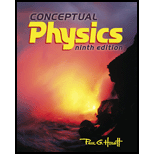
Your friend says that light passing the sun is bent whether or not Earth experiences a solar eclipse. Do you agree or disagree, and why?
To explain: Whether a person will agree with a friend or not.
Answer to Problem 36A
Agreed.
Explanation of Solution
Introduction:
According to the gravitational lensing, light emitted by distant celestial objects when passes by massive objects, distorts or bends the light.
When light emitted by celestial objects passes by Sun experienced by an observer on Earth then due to space-time curvature is curved, lights bend. When the solar eclipse is experienced by an observer, then a better view is observed of the celestial object. Light passes through massive objects like Sun is blocked during the eclipse and a clear view of the celestial object is observed.
Conclusion:
Yes, it bends. In the eclipse, a better view is observed because the light emitted by Sun gets blocked. Therefore, a person will agree with his friend.
Chapter 16 Solutions
CONCEPTUAL PHYSICS-W/PRACTICING PHYSICS
Additional Science Textbook Solutions
Biology: Life on Earth with Physiology (11th Edition)
Anatomy & Physiology (6th Edition)
Microbiology: An Introduction
Campbell Essential Biology with Physiology (5th Edition)
Cosmic Perspective Fundamentals
Campbell Biology (11th Edition)
- Figure 8.14 shows a cube at rest and a small object heading toward it. (a) Describe the directions (angle 1) at which the small object can emerge after colliding elastically with the cube. How does 1 depend on b, the so-called impact parameter? Ignore any effects that might be due to rotation after the collision, and assume that the cube is much more massive than the small object. (b) Answer the same questions if the small object instead collides with a massive sphere.arrow_forward2. A projectile is shot from a launcher at an angle 0,, with an initial velocity magnitude vo, from a point even with a tabletop. The projectile hits an apple atop a child's noggin (see Figure 1). The apple is a height y above the tabletop, and a horizontal distance x from the launcher. Set this up as a formal problem, and solve for x. That is, determine an expression for x in terms of only v₁, 0, y and g. Actually, this is quite a long expression. So, if you want, you can determine an expression for x in terms of v., 0., and time t, and determine another expression for timet (in terms of v., 0.,y and g) that you will solve and then substitute the value of t into the expression for x. Your final equation(s) will be called Equation 3 (and Equation 4).arrow_forwardDraw a phase portrait for an oscillating, damped spring.arrow_forward
- A person is running a temperature of 41.0°C. What is the equivalent temperature on the Fahrenheit scale? (Enter your answer to at least three significant figures.) °Farrow_forwardWhat is the period of a rock of mass 2.0kg tied to the end of a spring 0.625m long string that hangs in a doorway and has an elastic constant of 40N/m?arrow_forwardGive an example of friction speeding up an object.arrow_forward
- Which is the higher temperature? (Assume temperatures to be exact numbers.) (a) 272°C or 272°F? 272°C 272°F They are the same temperature. (b) 200°C or 368°F? 200°C 368°F They are the same temperature.arrow_forwardWhat is the direction of a force vector given by ~v = −6Nˆi − 8Nˆj?arrow_forwardWhat can be said of the position vector of an object far from any influences on its motion?arrow_forward
- ་ Consider a ball sliding down a ramp as shown above. The ball is already in motion at the position 1. Which direction best approximates the direction of acceleration vector a when the object is at position 2?arrow_forwardPlease solve and answer the question correctly please. Thank you!!arrow_forwardPlease solve and answer the question correctly please. Thank you!!arrow_forward
 College PhysicsPhysicsISBN:9781305952300Author:Raymond A. Serway, Chris VuillePublisher:Cengage Learning
College PhysicsPhysicsISBN:9781305952300Author:Raymond A. Serway, Chris VuillePublisher:Cengage Learning University Physics (14th Edition)PhysicsISBN:9780133969290Author:Hugh D. Young, Roger A. FreedmanPublisher:PEARSON
University Physics (14th Edition)PhysicsISBN:9780133969290Author:Hugh D. Young, Roger A. FreedmanPublisher:PEARSON Introduction To Quantum MechanicsPhysicsISBN:9781107189638Author:Griffiths, David J., Schroeter, Darrell F.Publisher:Cambridge University Press
Introduction To Quantum MechanicsPhysicsISBN:9781107189638Author:Griffiths, David J., Schroeter, Darrell F.Publisher:Cambridge University Press Physics for Scientists and EngineersPhysicsISBN:9781337553278Author:Raymond A. Serway, John W. JewettPublisher:Cengage Learning
Physics for Scientists and EngineersPhysicsISBN:9781337553278Author:Raymond A. Serway, John W. JewettPublisher:Cengage Learning Lecture- Tutorials for Introductory AstronomyPhysicsISBN:9780321820464Author:Edward E. Prather, Tim P. Slater, Jeff P. Adams, Gina BrissendenPublisher:Addison-Wesley
Lecture- Tutorials for Introductory AstronomyPhysicsISBN:9780321820464Author:Edward E. Prather, Tim P. Slater, Jeff P. Adams, Gina BrissendenPublisher:Addison-Wesley College Physics: A Strategic Approach (4th Editio...PhysicsISBN:9780134609034Author:Randall D. Knight (Professor Emeritus), Brian Jones, Stuart FieldPublisher:PEARSON
College Physics: A Strategic Approach (4th Editio...PhysicsISBN:9780134609034Author:Randall D. Knight (Professor Emeritus), Brian Jones, Stuart FieldPublisher:PEARSON





